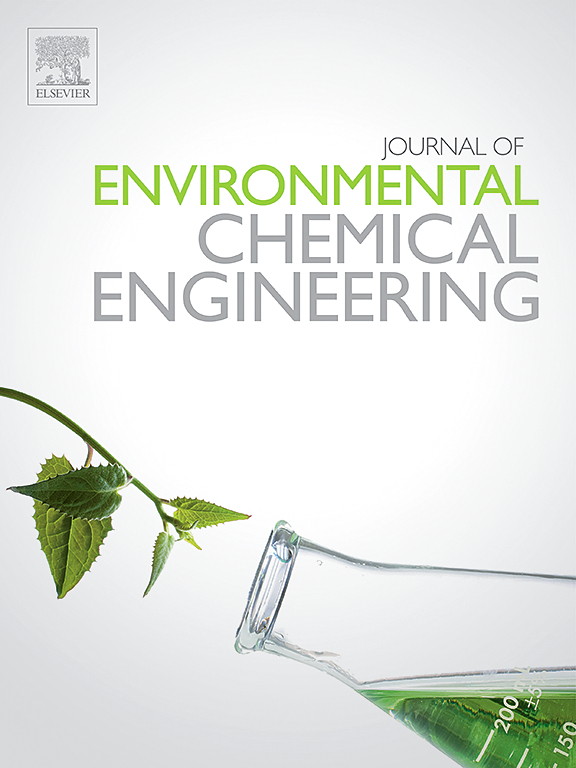Bipolar membranes with optimized interfacial catalyst loading and 3-D interface design facilitating performance in self-humidifying hydrogen fuel cell
IF 7.4
2区 工程技术
Q1 ENGINEERING, CHEMICAL
引用次数: 0
Abstract
Bipolar membranes (BPMs) are emerging as potential polymer electrolyte material for energy conversion technologies like fuel cells, redox-flow batteries, and CO2 electrolyzers. Water formation at the interface of forward bias BPM facilitates self-humidification in fuel cell and presence of different pH conditions (acidic-anode and alkaline-cathode) in this assembly promotes faster electrode half reactions. Amount of interface catalyst and design of interface in BPM play crucial role in kinetics of water formation. TiO2 nanoparticles (interface catalyst) of varying loading 0, 1, 2, 3, and 4 mg cm−2 were used to fabricate BPMs, and their electrochemical performance under forward bias were compared with that of commercial FBM fumasep® membrane. The BPM with 3 mg cm−2 (BPM-3) of TiO2 loading showed lowest potential drop, 0.20 V at applied current density of 50 mA cm−2 compared to BPM-0 (0.375 V) and FBM (0.24 V). The smooth interface of BPM was subsequently modified introducing square and cylindrical shape (3D corrugations over anion exchange layer), which was coated with 3 mg cm−2 (optimized) catalyst to obtain BPMs with modified interface geometry. BPMs with square corrugation (BPM-3-S) showed potential drop of 0.17 V at 50 mA cm−2 followed by BPM with cylindrical shape (BPM-3-C), 0.195 V under identical conditions. Finally, fuel cell performance test (without external humidification) was conducted with BPM-3-S, BPM-3, and BPM-0 based membrane electrode assemblies. The peak power densities noted were 578.1 mW cm−2 (BPM-3-S), 489.6 mW cm−2 (BPM-3), and 247.5 mW cm−2 (BPM-0). These findings elucidate catalyst loading and interface geometry strongly influence the performance of BPM under forward bias conditions.
具有优化界面催化剂负载和三维界面设计的双极膜提高了自湿氢燃料电池的性能
双极膜(bpm)作为一种有潜力的聚合物电解质材料,在燃料电池、氧化还原液流电池和二氧化碳电解槽等能量转换技术中崭露头角。在正向偏压BPM界面上形成的水有助于燃料电池中的自湿化,并且该组件中不同pH条件(酸性阳极和碱性阴极)的存在促进了更快的电极半反应。介面催化剂的用量和介面设计对成水动力学起着至关重要的作用。采用负载0、1、2、3和4 mg cm−2的TiO2纳米颗粒(界面催化剂)制备了bpm,并将其在正向偏压下的电化学性能与商用FBM fumasep®膜进行了比较。负载TiO2为3 mg cm−2的BPM (BPM-3)在施加电流密度为50 mA cm−2时,电位下降最小,为0.20 V,而负载TiO2为BPM-0(0.375 V)和FBM(0.24 V)。随后,引入方形和圆柱形(阴离子交换层上的三维波纹)修饰BPM的光滑界面,并在其表面涂覆3 mg cm−2(优化)催化剂,得到界面几何形状修饰的BPM。在相同条件下,方形波纹BPM (BPM-3- s)在50 mA cm−2时电位下降0.17 V,其次是圆柱形BPM (BPM-3- c),电位下降0.195 V。最后,使用基于BPM-3- s、BPM-3和BPM-0的膜电极组件进行燃料电池性能测试(没有外部加湿)。测得的峰值功率密度分别为578.1 mW cm−2 (BPM-3- s)、489.6 mW cm−2 (BPM-3)和247.5 mW cm−2 (BPM-0)。这些发现阐明了催化剂负载和界面几何形状对正向偏压条件下BPM的性能有很大影响。
本文章由计算机程序翻译,如有差异,请以英文原文为准。
求助全文
约1分钟内获得全文
求助全文
来源期刊

Journal of Environmental Chemical Engineering
Environmental Science-Pollution
CiteScore
11.40
自引率
6.50%
发文量
2017
审稿时长
27 days
期刊介绍:
The Journal of Environmental Chemical Engineering (JECE) serves as a platform for the dissemination of original and innovative research focusing on the advancement of environmentally-friendly, sustainable technologies. JECE emphasizes the transition towards a carbon-neutral circular economy and a self-sufficient bio-based economy. Topics covered include soil, water, wastewater, and air decontamination; pollution monitoring, prevention, and control; advanced analytics, sensors, impact and risk assessment methodologies in environmental chemical engineering; resource recovery (water, nutrients, materials, energy); industrial ecology; valorization of waste streams; waste management (including e-waste); climate-water-energy-food nexus; novel materials for environmental, chemical, and energy applications; sustainability and environmental safety; water digitalization, water data science, and machine learning; process integration and intensification; recent developments in green chemistry for synthesis, catalysis, and energy; and original research on contaminants of emerging concern, persistent chemicals, and priority substances, including microplastics, nanoplastics, nanomaterials, micropollutants, antimicrobial resistance genes, and emerging pathogens (viruses, bacteria, parasites) of environmental significance.
 求助内容:
求助内容: 应助结果提醒方式:
应助结果提醒方式:


